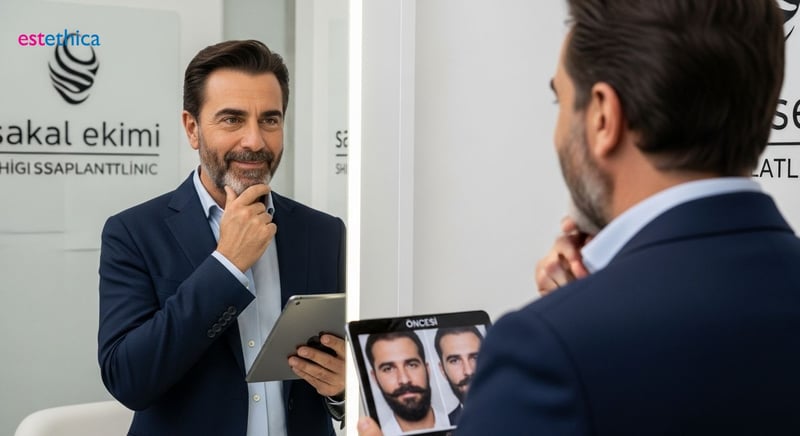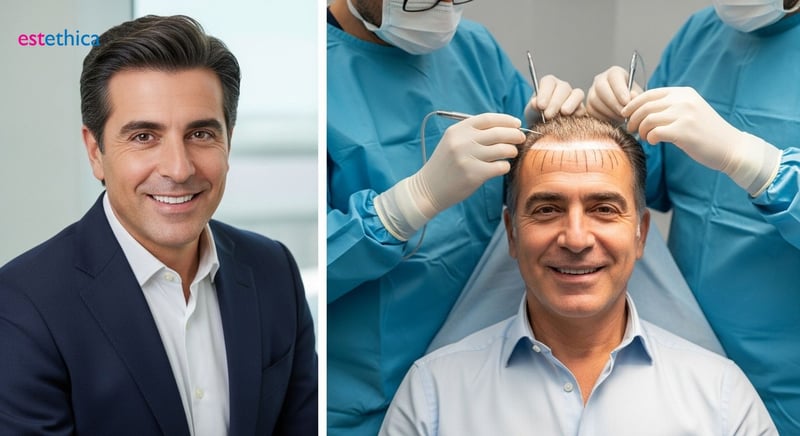Mastering Beard Transplants: Your Guide to Facial Hair Restoration
A comprehensive guide to beard transplants, covering FUE and DHI techniques, cost expectations, recovery timelines, and achieving natural-looking results for facial hair restoration.
Understanding Beard Implants: FUE & DHI Techniques Explained
The journey to a robust and well-defined beard often begins with understanding the advanced techniques employed in modern hair transplantation. For individuals seeking to enhance their facial hair, particularly through beard implants, two primary methods consistently stand out: Follicular Unit Extraction (FUE) and Direct Hair Implantation (DHI). Both approaches represent a significant evolution in hair restoration, offering minimally invasive solutions aimed at achieving natural-looking and dense results.
FUE, a widely recognized technique, involves the meticulous extraction of individual follicular units—each containing one or more hair follicles—from a donor area, most commonly the back or sides of the scalp. These carefully harvested units are then expertly implanted into the specific areas of the beard that require augmentation. This precise placement is key to mimicking the natural density and growth patterns of existing facial hair.
The Precision of DHI: A Refined Approach
DHI can be considered a sophisticated refinement of the FUE technique. It utilizes a specialized instrument known as the Choi implanter pen. This innovative device performs three crucial functions in a single, fluid motion: it simultaneously extracts the follicular unit, creates the recipient site within the beard area, and implants the graft. This integrated process offers enhanced precision and superior control over the angle, depth, and direction of each implanted follicle. Such meticulous attention to detail is paramount for achieving an aesthetically pleasing outcome that seamlessly integrates with your natural beard growth. The ability to precisely control these parameters is what helps create the most natural appearance for beard implants.
Both FUE and DHI techniques are celebrated for their minimally invasive nature, significantly reducing scarring and shortening the recovery period when compared to older, more traditional strip harvesting methods. This makes them the preferred choices for effective beard transplants. While both methods yield excellent results, the ultimate decision between FUE and DHI often hinges on the surgeon's specialized experience and the unique requirements and goals of each patient undergoing facial hair restoration. For those interested in a broader overview of hair restoration, exploring Saç Ekimi: Kapsamlı Saç Restorasyon Rehberi can provide valuable complementary insights into the world of hair transplantation procedures.

Beard Transplant Cost: What to Expect for Your Investment
Understanding the investment required for facial hair restoration is a key consideration for many individuals. The cost associated with a beard transplant can vary significantly based on several contributing factors. These typically include the number of grafts needed to achieve your desired density and coverage, the overall complexity of the procedure tailored to your unique facial structure, the geographical location of the clinic, and the renowned experience of the surgeon performing the transplant. Generally, such procedures are priced on a per-graft basis.
For areas requiring less density, fewer grafts might be necessary, naturally leading to a lower overall financial commitment. Conversely, individuals seeking a more dramatic transformation or requiring coverage for larger areas of sparse or absent facial hair will necessitate a greater number of grafts, which will, in turn, increase the total investment. Advanced techniques like Follicular Unit Extraction (FUE) and Direct Hair Implantation (DHI), while often involving a higher upfront cost due to the precision, specialized equipment, and the meticulous skill involved, typically yield superior aesthetic outcomes and more natural-looking results. These advanced methods are often considered a worthwhile investment for comprehensive beard implants, ensuring a result that seamlessly integrates with existing hair patterns.
Factors Influencing the Investment
When considering the financial aspect of enhancing your beard, it's essential to view the beard transplant cost not merely as an expense but as a strategic investment in your appearance, self-esteem, and overall confidence. Engaging in thorough consultations with reputable and experienced clinics is paramount. During these consultations, you will receive a detailed breakdown of the projected costs, specifically tailored to your individual facial hair restoration objectives. It is also crucial to proactively inquire about precisely what is included within the provided quote. This should encompass all pre-operative consultations, the surgical procedure itself, comprehensive post-operative care instructions and supplies, and any scheduled follow-up appointments necessary to monitor your healing progress and the final outcome. For a more in-depth understanding of the process and what a beard transplant entails, you might find it helpful to consult Beard Transplant: Your Guide to Fuller Facial Hair, which offers valuable insights into the journey towards achieving your desired beard density.
Maximizing Your Return on Investment
The long-term satisfaction derived from a beard transplant is directly linked to the quality of the procedure and the expertise of the surgical team. Prioritizing clinics known for their natural-looking results and patient care ensures that your investment yields the desired aesthetic benefits. Remember, the goal of beard implants is to provide a result that is both aesthetically pleasing and sustainable. Choosing a skilled surgeon and following all post-operative care guidelines diligently will significantly contribute to the success and longevity of your enhanced facial hair. This proactive approach ensures that your investment in beard enhancement provides lasting confidence and a natural appearance for years to come.
Beard Transplant Recovery: Timeline and Tips for Success
The recovery period following a beard transplant is a crucial phase that directly impacts the final outcome of your facial hair restoration. While the procedure is minimally invasive, diligent post-operative care is essential for optimal healing and graft survival. Understanding the typical timeline and adhering to recommended practices will significantly contribute to achieving the desired full and natural appearance. For those considering this procedure, exploring the comprehensive guide "Beard Transplant: Your Ultimate Facial Hair Restoration Journey" can provide valuable insights into the entire process.
Post-Operative Timeline and What to Expect
Immediately after the beard implants procedure, patients may experience minor swelling and redness in the treated area. Most clinics provide specific instructions, including avoiding direct sun exposure, strenuous physical activity, and touching or scratching the newly transplanted follicles. During the first week, small scabs may form around each graft site; these typically fall off naturally within 7-10 days. A significant milestone is when the transplanted hairs begin to shed – this is a normal part of the process, usually occurring 2-4 weeks post-procedure, and should not be mistaken for failure. New, permanent hair growth typically becomes noticeable within 3-4 months, with continued thickening and density appearing over the following 12-18 months. Patience is key as the full results gradually emerge.
Key Milestones and Recovery Tips
To ensure a smooth recovery and successful facial hair restoration, adherence to your surgeon's aftercare recommendations is paramount. This includes gentle cleansing of the area and avoiding certain products that might irritate the healing grafts. Maintaining a healthy lifestyle, with adequate hydration and nutrition, also plays a vital role in supporting the body's healing processes and promoting healthy hair growth. For a clearer overview of the recovery stages, consider the following comparison table:
Following these guidelines diligently will help ensure your beard transplant leads to the desired full and natural appearance. Remember that each individual's recovery can vary slightly, so open communication with your surgeon is always encouraged.

The Natural Look: Beard Transplant Before & After Insights
Achieving a natural-looking result is the ultimate goal for anyone seeking facial hair restoration through beard implants. Modern techniques, especially Follicular Unit Extraction (FUE) and Direct Hair Implantation (DHI), are meticulously designed with this precise objective in mind. Surgeons carefully plan the hairline, density, and angle of each transplanted graft to perfectly mimic the natural growth patterns of existing facial hair. This level of detail ensures that the restored beard seamlessly integrates with your own, appearing as if it has always been there.
Crafting Authenticity: The Art of Natural Beard Restoration
Before and after comparisons offer compelling evidence of the transformative power of these procedures. Before photos typically reveal areas of sparseness, patchiness, or a lack of desired shape and fullness. These images highlight the common concerns that lead individuals to seek a solution for their facial hair. In contrast, after photos showcase a significantly fuller, more defined, and harmoniously integrated beard. The key to this transformation lies in the surgeon's expertise in creating a result that is indistinguishable from naturally grown facial hair. This involves precise implantation angles, ensuring hairs grow outwards and slightly downwards, mirroring the natural direction of beard growth. Furthermore, the careful selection of donor hair that closely matches the texture and color of the recipient facial hair is paramount for a truly authentic appearance. For those interested in a deeper dive into the process and potential outcomes, exploring resources like Beard Transplant: Achieve Fuller, Natural Facial Hair can provide valuable insights and help set realistic expectations.
The commitment to natural aesthetics extends to every aspect of the beard transplant journey. From the initial consultation, where your desired look is discussed and a personalized plan is created, to the final result, the focus remains on achieving a look that enhances your unique features. Experienced surgeons utilize their understanding of facial anatomy and hair growth dynamics to place each graft strategically, ensuring optimal coverage and a natural density. This attention to detail is what distinguishes a truly successful beard transplant from one that may appear artificial. Examining before and after galleries can provide compelling visual evidence of the potential for successful facial hair restoration and demonstrate how modern beard implants can dramatically enhance confidence and overall facial aesthetics. The ability to regain a full and well-shaped beard significantly impacts an individual's self-perception and social interactions.

Mastering Beard Implants with FUE & DHI Techniques for Natural Facial Hair Restoration
Experience the precision of advanced beard transplantation, utilizing both Follicular Unit Extraction (FUE) and Direct Hair Implantation (DHI) methods. These cutting-edge techniques are designed for meticulous follicular unit extraction, ensuring minimal invasiveness and optimal graft survival for dense, natural-looking results.
The DHI technique represents a sophisticated refinement of FUE, offering enhanced control during the implantation phase. This advanced approach allows for precise placement of each hair follicle, contributing to the most natural beard density improvement and overall facial hair restoration.
Our expertise in facial hair restoration is built on a deep understanding of hair transplant techniques, including specialized FUE and DHI beard transplant procedures. We focus on delivering customized solutions, from full beard transplants to targeted beard enhancement, ensuring every patient achieves their desired aesthetic.
We are dedicated to employing the latest advancements in beard reconstruction and hair restoration, ensuring that each procedure is performed with the highest standards of care and precision. This commitment guarantees effective facial hair solutions and reconstructive capabilities for a visibly improved appearance.
Your Beard Transplant Recovery: A Seamless Journey to Full Facial Hair
Adhering to comprehensive beard transplant recovery timelines and expert tips is paramount for successful facial hair restoration. We provide detailed guidance to ensure a smooth post-operative experience, enabling your beard implants to flourish and deliver the desired results.
Post-operative care is meticulously managed to support optimal healing and graft integration. Immediate aftercare focuses on minimizing discomfort and promoting natural beard results, setting the stage for the long-term satisfaction derived from your beard transplant.
Patients consistently report satisfaction with the natural appearance achieved through our beard transplant procedures. We ensure that the final look of your beard is authentic and aesthetically pleasing, fulfilling the ultimate goal of facial hair restoration.
The long-term satisfaction derived from a beard transplant is directly linked to the quality of the procedure and the expertise of the surgical team. We are committed to ensuring your beard transplant leads to the desired full and natural appearance, enhancing your confidence and look.